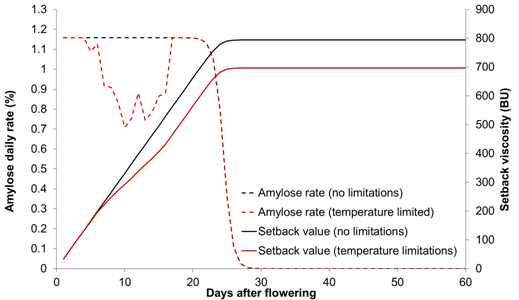This model calculates the setback viscosity of rice starch as a function of amylose accumulation rates and average air temperature perceived by the crop along the ripening period. Intensity and duration of variety-specific sensitivity to temperature effect during amylose synthesis are both considered.
The setback value at the day "i" is simulated using the following equation (Figure1):

Where:
Si (BU) is the setback viscosity of rice starch at the day i;
SR (BU) is the daily accumulation rate of setback viscosity of rice starch.

Figure 1. Amylose daily rate (left-y-axis; %) and setback viscosity accumulation (right y-axis; BU) along the ripening period. The dotted black line represents the maximum daily rate of amylose accumulation that can be reached under optimum temperature conditions, whereas the dotted red one indicates the actual amylose rate due the effect of suboptimal thermal regimes.The filled black line represents the potential setback viscosity that can be achieved under optimum temperature conditions, whereas the filled red one indicates the actual setback viscosity due the effect of suboptimal thermal regimes.
The daily accumulation rate of setback viscosity is calculated as follow:

Where:
ARmax (%) is the maximum amylose accumulation rate of the rice variety selected for the simulation;
DFFi (d) are the days since flowering date;
TFi (unitless) is a temperature factor (1 no limitation, 0 maximum limitation) accounting for the temperature effect on amylose synthesis;
a (0.025 for Loto, 0.035 for Gladio; unitless), b (16.8813 for Loto, 37.0865 for Gladio; unitless), c (0.5644 for Loto, 1.5141 for Gladio; unitless),are coefficients of the equation.
The daily thermal limitation to amylose accumulation due to suboptimal temperatures is calculated as follow:

Where:
TFi (unitless) is the temperature factor (1 no limitation, 0 maximum limitation) accounting for the temperature effect on amylose accumulation;
SSTTstart (d) is a varietal parameter representing the doy after flowering at which the amylose accumulation start to be sensitive to suboptimal thermal regimes;
SSTTend (d) is a varietal parameter representing the doy after flowering at which the amylose accumulation ceases to be sensitive to suboptimal thermal regimes;
.
The factor accounting for the temperature effect on amylose synthesis is calculated using the following equation:

Where:
VSST (unitless) is a parameter representing the varietal sensitivity (0 maximum sensitivity, 1 no sensitivity) to suboptimal thermal regimes during the amylose synthesis;
Ti (°C) is the average daily temperature of the day i;
Tmin (°C) is a parameter representing the minimum temperature threshold for the grain amylose synthesis;
Tmax (°C) is a parameter representing the maximum temperature threshold for the grain amylose synthesis;
ToptL (°C) is a parameter representing the lower optimum temperature threshold for the grain amylose synthesis;
ToptM (°C) is a parameter representing the higher optimum temperature threshold for the grain amylose synthesis;
α, β, γ , δ (unitless) are coefficients of the equation.
α is calculated as:

β is calculated as:

γ is calculated as:

δ is calculated as:

Created with the Personal Edition of HelpNDoc: Free PDF documentation generator